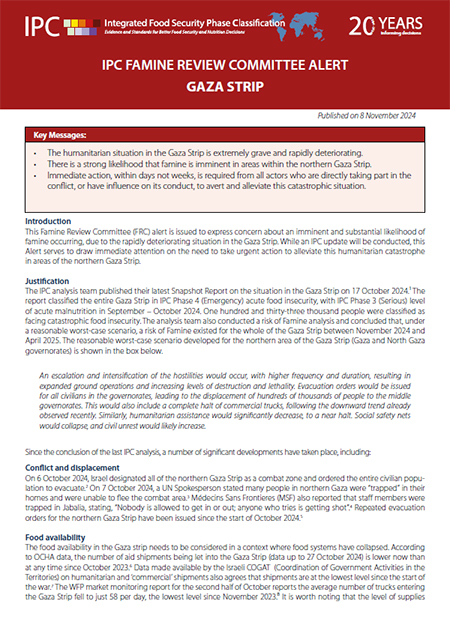17.10.2024
01.09.2024 > 30.04.2025
Map
Projected Map
Other Projections



Key
results
Recommendations
& next steps
Acute
Malnutrition
Acute malnutrition is expected to worsen in all governorates, driven by seasonal diseases in high-density population settings alongside reduced assistance to children and pregnant and breastfeeding women. In Rafah, the deterioration is expected to reach critical level (IPC AMN Phase 4). Prioritizing children’s meals over adults, and the inflow of life-saving nutrition assistance, including blanket supplementary feeding of children with fortified, high-calorie foods have been crucial to reverse the deterioration of acute malnutrition. Nonetheless, the expected reduction of humanitarian assistance, soaring food prices, reduced access to fresh food, and the collapse of the health and WASH systems are expected to have a negative impact on the nutrition situation in the projected period. Among children aged 6 to 59 months, an estimated 60,000 cases of acute malnutrition, of which 12,000 severe cases, are expected between September 2024 and August 2025.
The risk of Famine between November 2024 and April 2025 persists as long as conflict continues, and humanitarian access is restricted. The extreme concentration of population in an ever-shrinking area, living in improvised shelters with intermittent access to humanitarian supplies and services, elevates the risk of epidemic outbreaks and deterioration into a catastrophe of unprecedented magnitude. Attacks on camps, shelters and infrastructure across the Gaza strip, as well as renewed evacuation orders in North Gaza in the past two weeks, are already increasing the likelihood of this worst-case scenario occurring.
GAZA STRIP: Famine Review Committee Alert
Key Messages:
- The humanitarian situation in the Gaza Strip is extremely grave and rapidly deteriorating.
- There is a strong likelihood that famine is imminent in areas within the northern Gaza Strip.
- Immediate action, within days not weeks, is required from all actors who are directly taking part in the conflict, or have influence on its conduct, to avert and alleviate this catastrophic situation.
This FRC alert is issued to express concern about an imminent and substantial likelihood of famine occurring, due to the rapidly deteriorating situation in the Gaza Strip. While an IPC update will be conducted, this Alert serves to draw immediate attention on the need to take urgent action to alleviate this humanitarian catastrophe in areas of the northern Gaza Strip.
Download the FRC alert
Country Related Information
Contacts
- 01.04.2025 > 31.03.2026
Gaza Strip: Acute Malnutrition Situation for April 2025 - March 2026 - 01.04.2025 > 30.09.2025
Gaza Strip: Acute Food Insecurity Situation for 1 April - 10 May 2025 and Projection for 11 May - 30 September 2025 - 01.09.2024 > 30.04.2025
Gaza Strip: Acute Food Insecurity Situation for September - October 2024 and Projection for November 2024 - April 2025 - 01.05.2024 > 30.09.2024
Gaza Strip: Acute Food Insecurity Situation for 1 May - 15 June and Projection for 16 June - 30 September 2024 - 15.02.2024 > 15.07.2024
Gaza Strip: Acute Food Insecurity Situation for 15 February - 15 March 2024 and Projection for 16 March - 15 July 2024 - 24.11.2023 > 07.02.2024
Gaza Strip: Acute Food Insecurity Situation for 24 November - 7 December 2023 and Projection for 8 December 2023 - 7 February 2024
Join our mailing list


